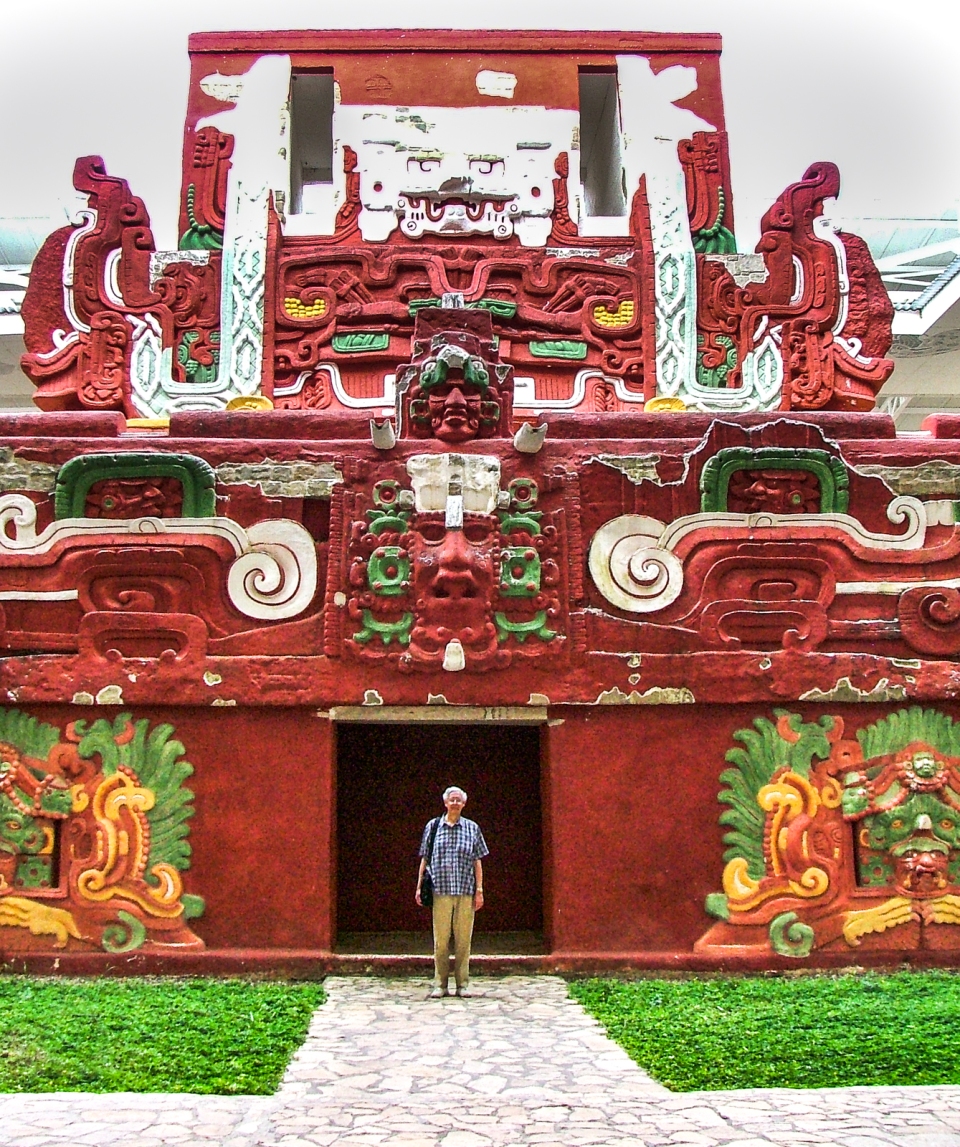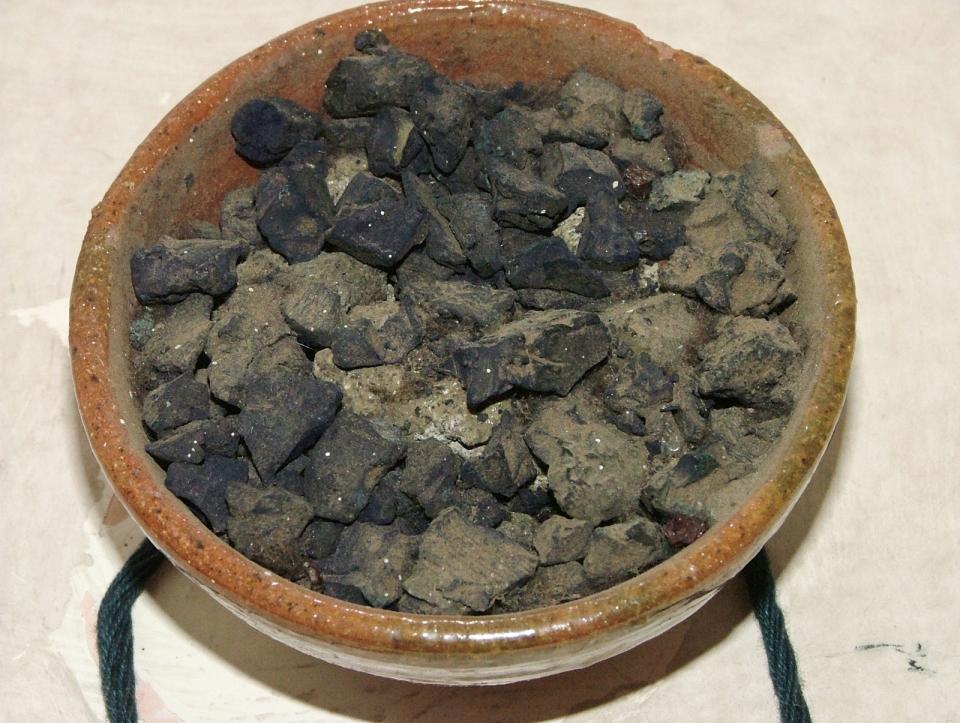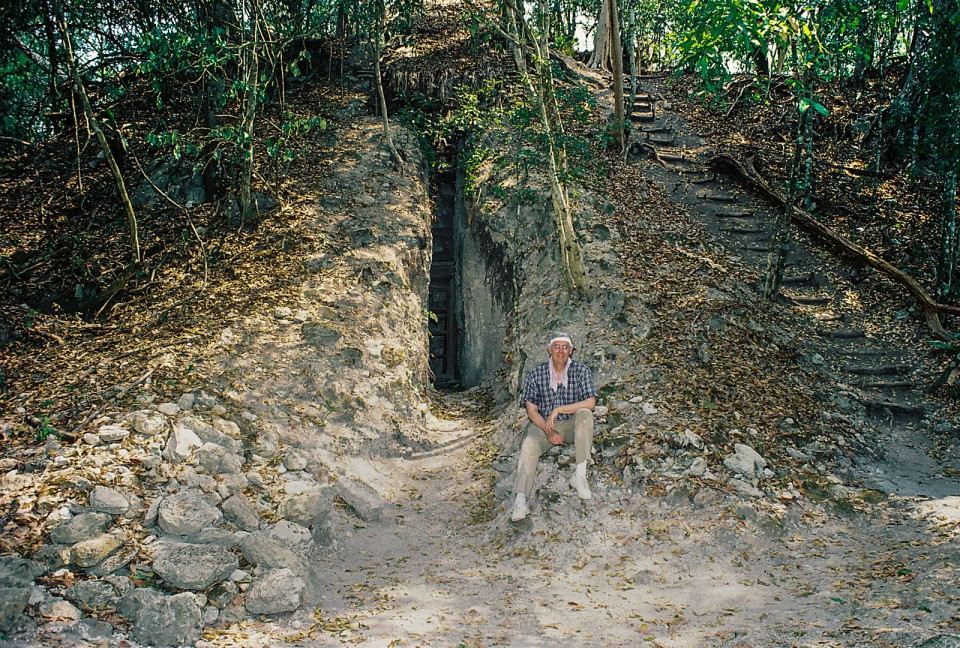Ancient Maya Color Symbolism

I’m standing in front of Rosalila, a life-size replica of a 6th century shrine, the centerpiece of the museum at the Copan, Honduras Archaeological Park. Although the structure was completely buried, it was found whole and in excellent condition with much of the original paint.
Inside, there were ceramic incense burners containing charcoal, two of which were resting on sculpted, stone jaguar pedestals. There were offerings of flint knives for sacrificing, nine elaborate ceremonial scepters wrapped in a deep blue bundle, carved jade jewelry, conch shells, stingray spines (for bloodletting rites), shark vertebrae, jaguar claws and the remains of flower petals and pine needles. The themes depicted in stucco around the structure are cosmological, emphasizing K’inich Ahau, the sun god, patron of Maya kings and namesake of K’inich Yax K’uk Mo’, founder of the Copan dynasty.
By the Late Preclassic (200 BC), the colors being used on architecture, monuments and clothing had clearly defined symbolic meanings.
- Red = East, sun, blood, sacrifice
- Yellow = South, food (maize)
- White = North, resplendent
- Black = West, Venus, water, regeneration
- Green = Precious, life-force
- Blue = Sacredness, divinity, sacrifice
Blue

Indigo. Pieces are ground into a power. The blue color deepens each time it’s exposed to the air.
The paint color referred to as “Maya Blue” eluded scientists for many years. Finally, it was determined to be part of the indigo-attapulgite clay complex. In pre-Columbian times it was mined at Sacalum, about 45 miles south of Merida, Yucatan. By mixing white palygorskite clay with the indigo-attapulgite they were able to create seven tones of blue ranging from ultramarine to Caribbean Sea blue. Even after centuries, the color barely faded. It defies exposure to acids, alkalis and solvents, and resists natural biodegradation. The color was used on gods, beads, serpents’ bodies, feathers, thrones, staffs, mirrors, mat motifs and depictions of divine infants, dwarfs and human sacrifices.
Yellow
Yellow was made by grinding iron oxide into a powder. The color could also be made from hematite. Both minerals are rare in the Maya area, found exclusively in the mountains of Guatemala and Honduras. Yellow was used on depictions of jaguar tails and spots, certain god elements and cross-hatched areas on sculptures and vases.
Cream
This color was derived from plants. In addition to red and black, cream colors were commonly used on the exterior of Middle Preclassic buildings. At Palenque the color was made by adding bark extract to thinned lime plaster to retard its curing.
White
As a symbol of royalty and purity, white was only worn by elites. On buildings, it was used as a base coat to prepare the surface for color. Lime stucco made from dolomitic limestones (most of the geology of the Yucatan Peninsula) provided the white. Its brightness was altered by the purity of the lime source and by mixing additional materials into it. High-fired lime was used as the final priming surface for color. An alternative source for white was grinding mollusk shells (calcium carbonate) to make a paste.
Green
Green paint was made by glazing Maya Blue with yellow iron oxide. Malachite was used to produce green in murals, and there were five different tones of it. Green was mostly used to paint quetzal feathers that were strictly reserved for the headdresses of rulers.
Black
Black was derived from carbon—charcoal and burnt bone. Both permanent and stable as a pigment, it was used to paint obsidian weapons and outline the red of certain buildings. Mixed with other colors on murals and sculptures it denoted hair and jaguar spots. Black was the dominant color of hieroglyphs on all surfaces, including the written records—codices.
Red
Red was considered the color of life (blood). It was associated with the middle world. The paint was made from either hematite or iron oxide from ant hills. Hematite can produce colors from dark orange browns to bright reds. Found in the volcanic highlands of Guatemala, it was an expensive import for the lowland sites. Small amounts of hematite produces an intense color that’s chemically stable.
The brightest red came from cinnabar, which is also found in the highlands, specifically in volcanic veins. Archaeologists often find royal remains covered in the powder. Symbolically, cinnabar provided the deceased with spiritual blood for the afterlife. An amazing example of this is the Tomb of the Red Queen at Palenque. In today’s terms, the value and use of cinnabar would be equivalent to completely covering a corpse in gold dust.

Cochineal. The insects are toasted and dried in the sun
To color textiles they used cochineal, derived from colonies of bacteria that live on prickly pear cactus. The dye has excellent light and wash fastness and produces a powerful range of fuchsias, reds and purples.
In the Late Preclassic (200 BC—200 AD), the combination of red and black was most common, symbolizing the path of the sun from east (red) to west (black).

Purpura patula.
Purple
A highly prized and colorfast deep purple for both paint and dye was obtained from a Pacific mollusk called purpura patula. Today in Mexico, the Mixtec and Oaxaca’s still search the seashore for this wide-mouthed shell. They squeeze juice from the glands onto yarns and return the shell to its home, to be used again the following season.

Holtun, Guatemala (1000—300 BC). After walking four yards into this looter’s tunnel I went another ten yards on hands and knees.

What I came to were several pieces of painted sculpture. They were too difficult to identify, but given the location they were likely part of a large frieze on the front of a temple. It would represent a king and perhaps references to his human and divine ancestors.
Fire Eyes Jaguar Paints a Shrine to the Ruler’s Son
Excerpt From Jaguar Rising (p. 433-434)
Lord Tapir dismissed Charcoal but he asked me to stay. The steward was still standing behind the throne with a baton in his folded arms, and the scribe made creases in a length of bark paper. And as always I could feel Blood Shark standing behind me. Every flick of the lord’s fly sweep made my insides tighten, wondering if he’d learned the truth about Thunder Flute and me.
“Fire Eyes Jaguar—.” His tone was unusually friendly. “Charcoal Conjurer tells us you know how they made the paint used on the shrine walls at First True Mountain—the bright red. Is that true?”
“With respect, it is.” Paint? He wants to talk about paint?
“Could you make that paint here?”
“If I had the ingredients.”
“What would you need?”
“They use a greater quantity of red hematite. To make it thick so it adheres better they put in powdered mollusk shell. To make it shine after it dries, they make a mixture of powdered mica with some clay powder and the juice of a certain orchid that grows on trees with morning sunlight. I know it when I see it. Also, there is a trick to adding the blood and mixing it.” Through my description he kept nodding.
“We can arrange for it, the blood as well. As the place where we will conjure the ch’ulel of our first son, the paint must be delectable to the gods. Do you understand?”
With all the grinding and mixing I’d done for my uncles I knew their secrets, so I assured the lord that I could make the paint delectable. “With respect Lord Tapir, may I ask if Charcoal Conjurer knows about this?”
Distracted by a squawking parrot, he ignored my question. “Construction of the conjuring house should be completed in three moons. That gives you less than twenty k’inob to gather what you need and make the paint. You will paint the walls inside and conjure our ancestors on the outside. It must all be completed before the first rains.”
“There will be conjuring?”
Lord Tapir gestured to the scribe with his fly-sweep. “This is how it shall be—Charcoal Conjurer will give the conjuring house its outer skin in Tikal red. Fire Eyes Jaguar will give the interior walls a skin of bright red, the one used in the shrines at Uaxactun. He will also conjure four of our ancestors, one on the four outside corners of the shrine. The circle of conjurers will provide the ingredients, tools and brushes. Fire Eyes Jaguar and his attendants will gather the rest. We will provide the sacrificial blood.” Lord Tapir waited for the scribe to catch up.
“After the first drop of color touches the chamber walls, only those with ancient blood may enter. Fire Eyes Jaguar alone will build his scaffolds and paint the interior. When that is completed, he alone will remove the scaffolds and broadleaves—and anything else.” He paused again.
I see now, he wants me to do the inside walls because my blood is hot.
“Before Fire Eyes Jaguar begins his conjurings on the outside corners, Charcoal Conjurer will conjure a Precious Night sky-band around the medial molding. He is not to enter the chamber and there will be no torches inside. No sandals. No food or women. When the skins are dry inside and out, Fire Eyes Jaguar—he alone—will conjure the ancestors, showing them standing guard in clouds of holy breath. Until we perform the fire-entering and dedication rites, Charcoal Conjurer and Fire Eyes Jaguar are the only ones permitted up the steps. Sentries will be posted to ensure that our words are carried out. This is how it shall be.”
____________________________________________________________________________
For a brief description of The Path Of The Jaguar novels: Go to the Home Page—Novels
Links To Amazon.com for paperback books and Kindle Editions
Jaguar Rising: A novel of the Preclassic Maya